Proxy Management: Navigating Proxy Solutions
In today’s world, capturing data and web scraping have become more complex due to advanced anti-bot measures and tracking

In today’s world, capturing data and web scraping have become more complex due to advanced anti-bot measures and tracking systems. Knowing how to manage proxies effectively is crucial for successful data collection. This skill involves not only technical implementation but also understanding different types of proxies, how to rotate them properly, and considering the ethical aspects of their use.
Types of Proxies
There are three main types of proxies: datacenter proxies, residential proxies, and mobile proxies.
- Datacenter proxies are IP addresses from data centers. They offer high speeds and low costs but can be easily detected by advanced security systems.
- Residential proxies come from home-based IPs provided by ISPs. They are harder to detect and block, making them a good balance between cost and performance, though they tend to be slower.
- Mobile proxies use IPs from mobile networks. They are the most expensive but provide high anonymity and can bypass geographical restrictions, making them ideal for specific tasks that need to mimic real users.
Choosing the right proxy type depends on your needs:
- For large-scale scraping of less sensitive sites, datacenter proxies might work.
- For accessing secure sites or e-commerce platforms, residential proxies are usually better.
- For tasks requiring high anonymity or location-specific targeting, mobile proxies are the best choice.
Proxy Rotation Strategies
Rotating IP addresses is essential to avoid detection and blocking. Proper rotation helps keep a low profile while accessing target sites. Here are some strategies for effective rotation:
- Timed Rotation: Switch IPs at regular intervals. This is simple but less flexible.
- Per-Request Rotation: Use a different IP address for each request. This approach is more diverse but might slow down the process.
- Smart Rotation: Use algorithms to choose the best IP addresses based on success rates, detection rates, and latency. This helps balance performance and security.
Optimizing Proxy Performance
To keep your proxy network running smoothly, you need to monitor its performance. Track response times, success rates, and error frequencies in real-time to identify and remove non-performing or blocked proxies.
Implement failover systems to automatically switch to backup proxies if one fails. Intelligent routing algorithms can help redirect traffic away from problematic proxies, reducing downtime and maintaining data collection efficiency.
Ethical and Legal Considerations
Using proxies comes with legal responsibilities. Make sure you understand the laws, including the terms of service for the websites you target and data protection regulations like GDPR or CCPA. While using proxies itself is not illegal, how you use them and the data you collect might have legal implications.
To protect your operations, encrypt all communications through proxies and control access to your proxy infrastructure. Regularly audit your data collection practices to ensure compliance with privacy regulations.
Conclusion
Understanding how to manage proxies effectively is key to successful web scraping and data collection. By choosing the right proxies, implementing effective rotation strategies, optimizing performance, and adhering to ethical guidelines, you can make the most out of your data collection efforts. Keep learning about proxy management as it evolves to stay ahead in this field.









